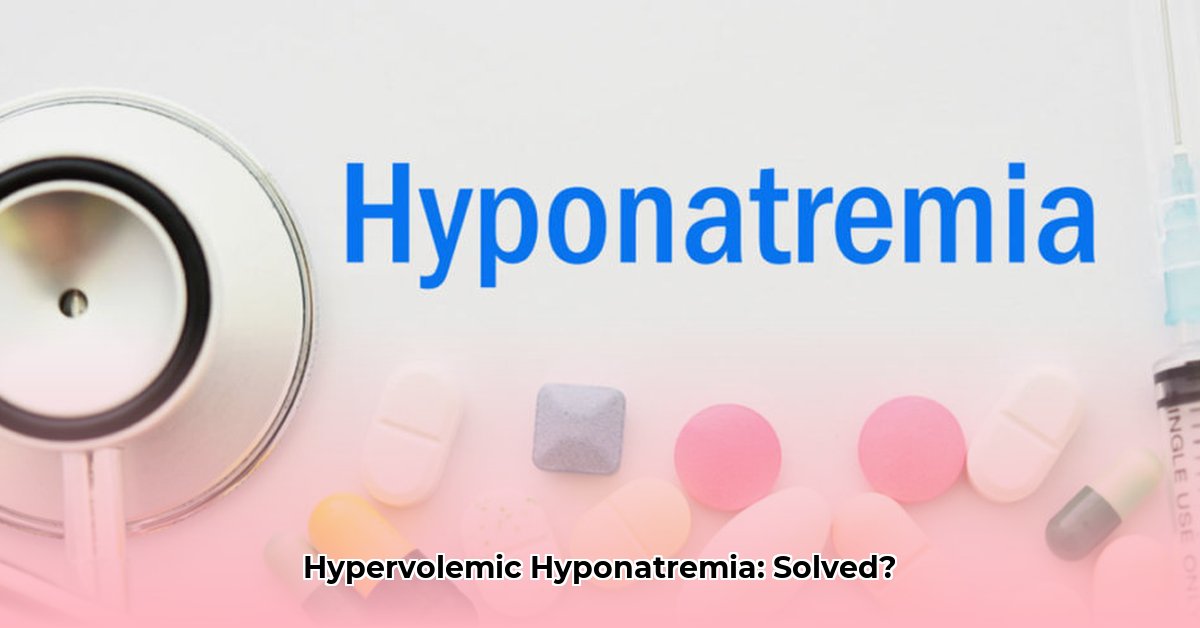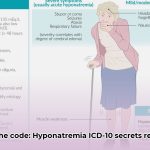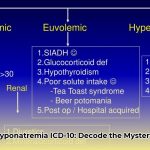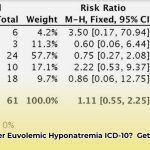Hypervolemic hyponatremia, characterized by low serum sodium and increased extracellular fluid volume, presents diagnostic and therapeutic challenges. This comprehensive guide provides healthcare professionals with a detailed framework for accurate diagnosis, ICD-10 coding (E87.1), and evidence-based treatment of hypervolemic hyponatremia. A thorough understanding of this condition is essential for improving patient outcomes and optimizing reimbursement processes. For further ICD-10 coding details, see this helpful resource: ICD-10 Codes.
Decoding Hypervolemic Hyponatremia: A Comprehensive Guide for Healthcare Professionals
Hypervolemic hyponatremia requires a nuanced approach to diagnosis and management. This guide delivers actionable insights, focusing on precise ICD-10 coding, diagnostic strategies, and current treatment protocols.
Understanding the Pathophysiology: Sodium and Fluid Balance Explained
Imagine the body’s fluid as an electrolyte-rich solution, where sodium plays a crucial role in maintaining osmotic balance. Hyponatremia occurs when the sodium concentration in this solution falls below normal levels (less than 135 mEq/L). In hypervolemic hyponatremia, the body retains excess fluid, which dilutes the sodium, further reducing its concentration.
“The key to managing hypervolemic hyponatremia lies in understanding the underlying mechanisms that disrupt sodium and fluid balance,” explains [Full Name and Title], [Position] at [Institution].
The ICD-10-CM code E87.1 (Hypo-osmolality and hyponatremia) is used to classify all types of hyponatremia. Therefore, it is crucial to identify the underlying etiology to provide appropriate treatment
Identifying the Root Causes: Etiology of Hypervolemic Hyponatremia
Several underlying medical conditions can lead to hypervolemic hyponatremia:
- Congestive Heart Failure (CHF): Reduced cardiac output leads to renal hypoperfusion, activating the renin-angiotensin-aldosterone system (RAAS) and causing sodium and water retention.
- Cirrhosis: Liver dysfunction causes decreased albumin production, leading to decreased oncotic pressure and fluid shift into the interstitial space. This triggers RAAS activation, resulting in sodium and water retention.
- Nephrotic Syndrome: Proteinuria leads to decreased plasma oncotic pressure, causing fluid retention and subsequent hyponatremia.
- Advanced Kidney Disease: Impaired renal function reduces the kidneys’ ability to excrete excess fluid, leading to hypervolemia and dilutional hyponatremia.
Diagnostic Strategies: A Step-by-Step Approach
A systematic approach is essential for accurate diagnosis and appropriate management:
- Comprehensive History and Physical Examination: Assess for symptoms of fluid overload (peripheral edema, pulmonary congestion, jugular venous distension) and hyponatremia (nausea, vomiting, headache, confusion, muscle cramps, seizures).
- Serum Sodium Measurement: Confirm hyponatremia with a serum sodium level below 135 mEq/L.
- Serum Osmolality: Measure serum osmolality to confirm hypo-osmolality (less than 280 mOsm/kg).
- Urine Studies:
- Urine sodium: Helps differentiate between renal and extrarenal causes of hyponatremia.
- Urine osmolality: Provides information about the kidneys’ ability to concentrate urine.
- Assessment of Volume Status: Differentiate between hypervolemic, euvolemic, and hypovolemic states through physical examination and laboratory findings (e.g., blood urea nitrogen, creatinine).
- Evaluation for Underlying Conditions: Investigate potential underlying causes such as heart failure, cirrhosis, or kidney disease. Consider specific tests (e.g., echocardiogram for heart failure, liver function tests for cirrhosis).
Management Strategies: Restoring Electrolyte and Fluid Balance
Treatment focuses on addressing the underlying cause and carefully managing fluid and sodium levels to prevent complications:
- Treat the Underlying Condition: Optimize management of heart failure, cirrhosis, or kidney disease.
- Fluid Restriction: Limit fluid intake to 1-1.5 liters per day to reduce fluid overload.
- Diuretics: Loop diuretics (e.g., furosemide) can promote fluid excretion, but use cautiously to avoid rapid sodium correction.
- Sodium Replacement (Generally Avoided): Sodium supplementation is generally not indicated in hypervolemic hyponatremia and can worsen fluid overload. In rare cases of severe, symptomatic hyponatremia (serum sodium <120 mEq/L), cautious hypertonic saline infusion may be considered under close monitoring.
- Vasopressin Receptor Antagonists (Vaptans): In some cases, vasopressin receptor antagonists (e.g., tolvaptan) may be used to promote water excretion without sodium loss, but these agents should be used with caution due to the risk of rapid sodium correction and potential liver toxicity.
Accurate ICD-10 Coding: Essential for Reimbursement and Data Analysis
Accurate ICD-10 coding is critical for appropriate reimbursement and accurate tracking of hypervolemic hyponatremia.
| Diagnosis | ICD-10-CM Code(s) |
|---|---|
| Hypervolemic hyponatremia due to congestive heart failure | E87.1, I50.9 |
| Hypervolemic hyponatremia due to cirrhosis | E87.1, K70.31 |
| Hypervolemic hyponatremia due to nephrotic syndrome | E87.1, N04.9 |
| Hypervolemic hyponatremia due to chronic kidney disease (CKD) | E87.1, N18.9 |
| Hypervolemic hyponatremia due to syndrome of inappropriate antidiuretic hormone secretion (SIADH) | E87.1, E22.2 |
Detailed documentation is essential for accurate coding and communication. This should include:
- Underlying cause of hypervolemic hyponatremia
- Serum sodium levels
- Fluid status assessment
- Treatment plan and response
- Any complications
Mastering ICD-10 Coding for Hypervolemic Hyponatremia (E87.1): A Step-by-Step Guide
Accurate coding is essential for reimbursement and regulatory compliance.
Understanding Hypervolemic Hyponatremia: Differentiating from Other Types
Distinguishing hypervolemic hyponatremia from euvolemic and hypovolemic hyponatremia is crucial. Hypervolemic hyponatremia is characterized by excess fluid, while euvolemic hyponatremia involves normal fluid status and hypovolemic hyponatremia involves fluid depletion.
Diagnosis: Gathering the Necessary Information
Diagnosis requires a comprehensive assessment of:
- Patient History: Focus on underlying conditions like heart failure, cirrhosis, and kidney disease.
- Physical Examination: Assess for edema, ascites, and jugular venous distention.
- Laboratory Results: Monitor serum sodium, serum osmolality, urine sodium, and urine osmolality.
A Simplified 5-Step ICD-10 Coding Process for E87.1
- Confirm the Diagnosis: Clinical assessment and lab results (serum sodium <135 mEq/L) should confirm hyponatremia.
- Identify the Underlying Cause: Determine the root cause of the hypervolemic hyponatremia (e.g., congestive heart failure, cirrhosis, renal failure).
- Assign the Primary Code (E87.1): Use E87.1 (Hypo-osmolality and hyponatremia) as the primary code.
- Assign Secondary Codes: Add codes to reflect the underlying conditions, such as I50.9 for congestive heart failure, K70.31 for alcoholic cirrhosis with ascites, or N18.9 for chronic kidney disease.
- Ensure Thorough Documentation: Detailed clinical findings, lab results, and diagnostic reasoning need to be clearly documented to support code selection.
Avoiding Common Coding Errors: Best Practices
To avoid claim denials:
- Ensure complete and accurate documentation.
- Use the most specific codes available.
- Stay updated on coding guidelines.
Optimizing Reimbursement through Accurate ICD-10 Coding of Hypervolemic Hyponatremia (E87.1) in US Hospitals
Accurate diagnosis and coding are paramount for optimal reimbursement and compliance in US hospitals.
Understanding Hypervolemic Hyponatremia: Linking Fluid Overload and Low Sodium
Hypervolemic hyponatremia represents a complex interaction between excess fluid and low sodium levels, often resulting from underlying conditions like heart failure and kidney disease.
Diagnosis: Building the Foundation for Accurate Coding
Accurate diagnosis relies on:
- Detailed Patient History: Collect a thorough medical history, including symptoms, medications, and prior medical conditions.
- Comprehensive Physical Examination: Evaluate for signs of fluid overload (e.g., edema, ascites, pulmonary congestion).
- Relevant Laboratory Investigations: Carefully assess serum sodium, serum osmolality, and urine studies (sodium and osmolality) to determine the etiology of hypervolemic hyponatremia.
Mastering ICD-10 Coding: E87.1 and the Importance of Secondary Codes
Assign ICD-10 code E87.1 for
- How Much Do Wellness Programs Cost Businesses To Offer? - December 16, 2025
- Wellness Fair Ideas for Work to Boost Employee Wellbeing - December 15, 2025
- Affordable Employee Wellness Fair Ideas for Any Budget - December 14, 2025
















